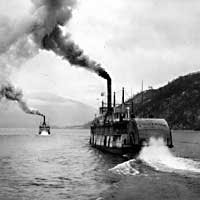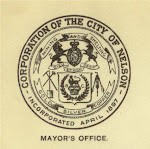Constructed: circa 1896
The area was originally known as “The Hoover Addition.”
This lovely home is very deceiving for at first glance you think it is a small cottage. This home is a massive two storey structure with 8 bedrooms. To best get a glimpse of the sheer size drive down the street behind the house and look at the side view.
There are many features original to the home with additional rooms constructed by the Sisters of St. Joseph of Peace in 1958.
Features:
• Stained Glass
• Great room and staircase
• Chapel and Confessional area (1958)
• Tin ceilings
• Mother Superior’s room (1958)
• Front Parlour and fireplace
• Hardwood floors
• Many original windows
• 8 Bedrooms - 7 from original home
• Much of the original home remains
• Numerous original chandeliers
The home was built by/for Robert Sheill circa 1896. These lots were purchased prior to the Fall auction of 1896. In the 1898 City Assessment the house is valued at $1500.00. The Fire Insurance Map of 1899 shows a structure of 1 1/2 storeys.
In the 1899 - 1902 City Assessment Rolls Tom Henderson is shown as the tenant of Mr. Sheill; and, in 1903 he is listed as the owner.
On 22 August 1904 Mr. Henderson sold the home to Nettie Elizabeth Blackwood*, wife of Clarence Dudley Blackwood. A large construction project commenced bringing the total bedrooms to seven (7) with a full second floor and large verandah.
The Blackwood Family consisted of four (4) daughters and a son. The eldest child, Donald Cameron Blackwood, 17, (1899-1916) was killed in a hunting accident at South Slocan on 30 September 1916. Mr. Blackwood was the only immediate family member to attend the funeral as the others were too distraught.
Mr. Blackwood (1877-1940) was the Gold Commissioner and Mining Recorder. Upon his retirement he went into the Insurance and Real Estate business. Mr. Blackwood is known as the “Father of Lacrosse in British Columbia.”
On 03 September 1940 Mr. Blackwood had a stroke and died shortly thereafter in the home. This was approximately two weeks after the body of his son in law, Dr. C.M. Bennett, MD, was located in Kootenay Lake (boating accident July 29, 1940). Mrs. Blackwood continued the Insurance and Real Estate business until her move to Victoria in 1958.
In the Fall of 1958 Mrs. Blackwood sold the home to the Sisters of St. Joseph of Peace to be used as their Residence/Convent and place of worship. Mrs. Blackwood (1880-1960) died in Victoria on 20 March 1960.
The home remained under the care of the Sisters for approximately 20 years. The Sisters constructed a Chapel and Confessional on the north side of the home soon after they took up residency.
This charming home is still under the watchful eye of a caring Nun. When construction workers were employed in the home after a water pipe break, one young man lit a cigarette. A Nun appeared to him, in full Habit, and advised him smoking was not permitted in the house. He then went outside and remarked to his friend that he thought the Nuns were no longer associated with the house. He was told they were not and had not been for many years! Perhaps it is due to the watchful, caring eye of the Sister that this home has such a warm and comfortable feeling.
This home was part of the 2007 Heritage Home Tour.
This home now operates as a lovely B&B, with charming hosts: http://www.simplybeandb.com/
* In 1873 women who owned property in British Columbia became the first in Canada to secure the right to vote in Municipal Elections.
The Obituary is from The Nelson Daily News, 04 September 1940; the picture of the Sisters of St. Joseph of Peace is from the The Nelson Daily News, 29 September 1958. Please click to enlarge.












































